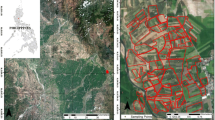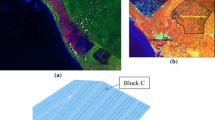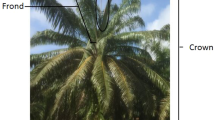Abstract
The application of remote sensing technology and precision agriculture in the oil palm industry is in development. This study investigated the potential of high resolution QuickBird satellite imagery, which has a synoptic overview, for detecting oil palms infected by basal stem rot disease and for mapping the disease. Basal stem rot disease poses a major threat to the oil palm industry, especially in Indonesia. It is caused by Ganoderma boninense and the symptoms can be seen on the leaf and basal stem. At present there is no effective control for this disease and early detection of the infection is essential. A detailed, accurate and rapid method of monitoring the disease is needed urgently. This study used QuickBird imagery to detect the disease and its spatial pattern. Initially, oil palm and non oil palm object segmentation based on the red band was used to map the spatial pattern of the disease. Secondly, six vegetation indices derived from visible and near infrared bands (NIR) were used for to identify palms infected by the disease. Finally, ground truth from field sampling in four fields with different ages of plant and degrees of infection was used to assess the accuracy of the remote sensing approach. The results show that image segmentation effectively delineated areas infected by the disease with a mapping accuracy of 84%. The resulting maps showed two patterns of the disease; a sporadic pattern in fields with older palms and a dendritic pattern in younger palms with medium to low infection. Ground truth data showed that oil palms infected by basal stem rot had a higher reflectance in the visible bands and a lower reflectance in the near infrared band. Different vegetation indices performed differently in each field. The atmospheric resistant vegetation index and green blue normalized difference vegetation index identified the disease with an accuracy of 67% in a field with 21 year old palms and high infection rates. In the field of 10 year old palms with medium rates of infection, the simple ratio (NIR/red) was effective with an accuracy of 62% for identifying the disease. The green blue normalized difference vegetation index was effective in the field of 10 years old palms with low infection rates with an accuracy of 59%. In the field of 15 and 18 years old palms with low infection rates, all the indices showed low levels of accuracy for identifying the disease. This study suggests that high resolution QuickBird imagery offers a quick, detailed and accurate way of estimating the location and extent of basal stem rot disease infections in oil palm plantations.










Similar content being viewed by others

Notes
PT is Peseroran Terbatas, or company limited.
References
Abdullah, F. (2000). Mapping of the incidence of basal stem rot of oil palms (Elaeis guineensis) on a former coconut (Cocos nucifera) plantation. In J. Flood, P. D. Bridge, & M. Holderness (Eds.), Ganoderma diseases of perennial crops (pp. 183–194). Wallingford: CABI Publishing.
Azahar, T. M., Boursier, P., & Seman, I. A. (2008). Spatial analysis of basal stem rot disease using geographical information system. In: Map Asia 2008, 18–20 August 2008, Kuala Lumpur, Malaysia. http://www.gisdevelopment.net/proceedings/mapasia/2008/.
Azahar, T. M., Seman, I. A., & Boursier, P. (2009). Spatial and hotspots analysis of basal stem rot disease in oil palm plantations: An analysis on peat soil. In: Map Asia 2009, 18–20 August 2008, Singapore. http://mapasia.org/2009/proceeding/proceeding.htm.
Coops, N. C., Johnson, M., Wulder, M. A., & White, J. C. (2006). Assessment of QuickBird high spatial resolution imagery to detect red attack damage due to mountain pine beetle infestation. Remote Sensing of Environment, 103, 67–80.
Corley, R. H. V., Hardon, J. J., & Wood, B. J. (Eds.). (1976). Oil palm research. Amsterdam: Elsevier.
Corley, R. H. V., & Tinker, P. B. (2004). The oil palm (Elaeis guineensis Jacq.) (4th edition ed.). Oxford: Wiley-Blackwell.
Danielsen, S., & Munk, L. (2003). Evaluation of disease assessment methods in quinoa for their ability to predict yield loss caused by downy mildew. Crop Protection, 23, 219–228.
Darmono, T. W. (2000). Ganoderma in Oil Palm in Indonesia: Current status and prospective use of antibodies for the detection of infection. In J. Flood, P. D. Bridge, & M. Holderness (Eds.), Ganoderma diseases of perennial crops (pp. 249–266). CABI Publishing: Wallingford.
Devadas, R., Lamb, D. W., Simpfendorfer, S., & Backhouse, D. (2004). Evaluating ten spectral vegetation indices for identifying rust infection in individual wheat leaves. Precision Agriculture, 10, 459–470.
Dutta, R. (2006). Assessment of tea bush health and yield using geospatial techniques. MSc Thesis, International Institute for Geo-information Science and Earth Observation. Eschende: ITC & IIRS. http://www.gisdevelopment.net/thesis/thesis7/.
Goodwin, N. R., Coops, N. C., Wulder, M. A., Gillanders, S., Schroeder, T. A., & Nelson, T. (2008). Estimation of insect infestation dynamics using a temporal sequence of Landsat data. Remote Sensing of Environment, 112, 3680–3689.
Huete, A. R. (1988). A soil-adjusted vegetation index (SAVI). Remote Sensing of Environment, 25, 295–309.
Jensen, J. R. (2004). Introductory digital image processing (3rd ed.). New Jersey: Prentice Hall.
McBratney, A., Whelan, B., Ancev, T., & Bouma, J. (2005). Future directions of precision agriculture. Precision Agriculture, 6, 7–23.
McMorrow, J. (2001). Linear regression modelling for the estimation of oil palm age from Landsat TM. International Journal of Remote Sensing, 22, 2243–2264.
Naert, B., Gal, R., Lubis, A. U., Suwandi, & Olivin, J. (1990). Preliminary evaluation of the possibilities of using spatial remote sensing to study developments on an oil palm plantation in North Sumatra. Oléagineux, 45, 201–214.
Nguyen, H. V., Lukman, F., Caliman, J. P., & Flori, A. (1995). SPOT image as a visual tool to assess sanitary, nutrient and general status of estate oil palm plantation. In A. Ibrahim & M. J. Ahmad (Eds.), Proceedings of the 1993 PORIM international palm oil congress (pp. 548–554). Kuala Lumpur: Palm Oil Research Institute Malaysia.
Perry, E. M., & Davenport, J. R. (2007). Spectral and spatial difference in response of vegetation indices to nitrogen treatments on apple. Computers and Electronics in Agriculture, 59, 56–65.
Pozdnyakova, L., Oudemans, P. V., Hughes, M. G., & Gimenez, D. (2002). Estimation of spatial and spectral properties of phytophthora root rot and its effects on cranberry yield. Computers and Electronics in Agriculture, 37, 57–70.
PTPN IV. (2008). Plant performances and basal stem rot disease monitoring in Dolok Ilir Plantation, a part of PT, September 2008. Simalungun, North Sumatera: Perkebunan Nusantara IV.
Rees, R. W., Flood, J., Hasan, Y., Potter, U., & Cooper, R. M. (2009). Basal stem rot of oil palm (Elaeis guineensis): Mode of root infection and lower stem invasion by Ganoderma boninense. Plant Pathology, 58, 982–989.
Robert, P. C. (2002). Precision agriculture: A challenge for crop nutrition management. Plant and Soil, 247, 143–149.
Shafri, H. Z. M., & Hamdan, N. (2009). Hyperspectral imagery for mapping disease infection in oil palm plantation using vegetation indices and red edge techniques. American Journal of Applied Sciences, 6, 1031–1035.
Sharp, C. R., Perry, A. L., Scharen, G. O., Boatwright, D. C., Sands, L. F., Lautenschiager, et al. (1985). Monitoring cereal rust development with a spectral radiometer. Phytopathology, 75, 936–939.
Sudharto, P., Syamsuddin, E., Darmosarkoro, W., & Purba, A. (2005). The land cover crop and weeds in the oil palm plantation. Books I and II. Medan: Indonesian Oil Palm Research Institute.
Susanto, A., Sudharto, P. S., & Purba, R. Y. (2005). Enhancing biological control of basal stem rot disease (Ganoderma boninense) in oil palm plantations. Mycopathologia, 159, 153–157.
Tamaluddin, S., & Kamaruzaman, J. (1999). Remote sensing (RS) and geographic information system (GIS) technology for field implementation in Malaysian agriculture. Seminar on repositioning agriculture industry in the next millennium, 13–14 July 1999. Serdang: Universiti Putra Malaysia.
Taylor, J. A., McBratney, A. B., & Whelan, B. M. (2007). Establishing management classes for broadacre agricultural production. Agronomy Journal, 99, 1366–1376.
Thenkabail, P. S., Stucky, N., Griscom, B. W., Ashton, M. S., Diels, J., Van Der Meer, B., et al. (2004). Biomass estimations and carbon stock calculations in the oil palm plantations of African derived savannas using IKONOS data. International Journal of Remote Sensing, 25, 5447–5472.
Turner, P. D. (1981). Oil palm diseases and disorders. Oxford: Oxford University Press.
Wahid, M. B., Abdullah, S. N. K., & Henson, I. E. (2004). Oil palm––achievements and potential. In T. Fischer (Ed.), 4th international crop science congress, September 2004, Brisbane, Australia. Gosford: The Regional Institute Ltd.
Wang, F. M., Huang, J. F., Tang, Y. L., & Wang, X. Z. (2007). New vegetation index and its application in estimating leaf area index of rice. Rice Science, 14, 195–203.
Wu, J., Wang, D., Rosen, C. J., & Bauer, M. E. (2006). Comparison of petiole nitrate concentrations, spad chlorophyll readings, and QuickBird satellite imagery in detecting nitrogen status of potato canopies. Field Crops Research, 101, 96–103.
Yang, C. M. (2010). Assessment of the severity of bacterial leaf blight in rice using canopy hyperspectral reflectance. Precision Agriculture, 11, 61–81.
Acknowledgements
The researchers would like to acknowledge the Director of Indonesian Oil Palm Research Institute (IOPRI) in providing the grant for this research. Mr. Agus Susanto, A. Fadillah Lubis, Tumin and Sanip who provided great help in the field and Mr. Michael Short who corrected the paper. The authors thank Dr. Margaret Oliver and two anonymous reviewers for their useful comments.
Author information
Authors and Affiliations
Corresponding author
Rights and permissions
About this article
Cite this article
Santoso, H., Gunawan, T., Jatmiko, R.H. et al. Mapping and identifying basal stem rot disease in oil palms in North Sumatra with QuickBird imagery. Precision Agric 12, 233–248 (2011). https://doi.org/10.1007/s11119-010-9172-7
Published:
Issue Date:
DOI: https://doi.org/10.1007/s11119-010-9172-7



